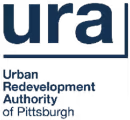In 2014, the area bounded by Railroad Street, the former Pennsylvania Railroad Yards (now the site of a residential complex), 22nd Street, Liberty Avenue and 15th Street was designated by the National Park Service as the Strip Historic District, a National Historic District listed on the National Register of Historic Places.
Today, the Strip Historic District sits at the heart of the larger Strip District neighborhood which spans from 11th to 33rd Streets and the Allegheny River to the Hill District.
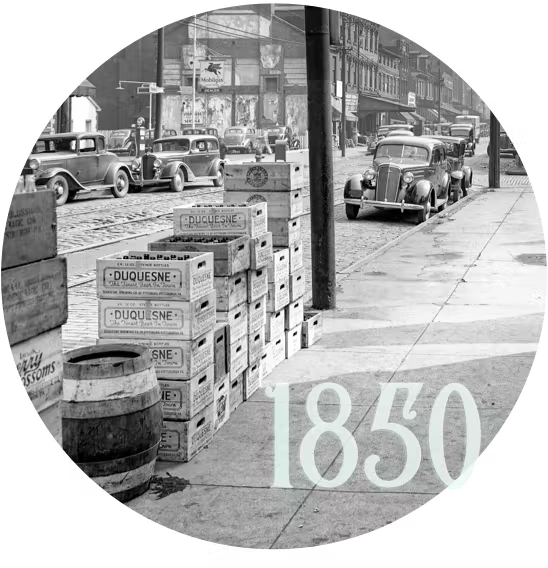
Strip Historic District
From 1850 to 1964, the 13-block parcel made a significant contribution to Pittsburgh's commercial history, and its architecture continues to define the neighborhood.
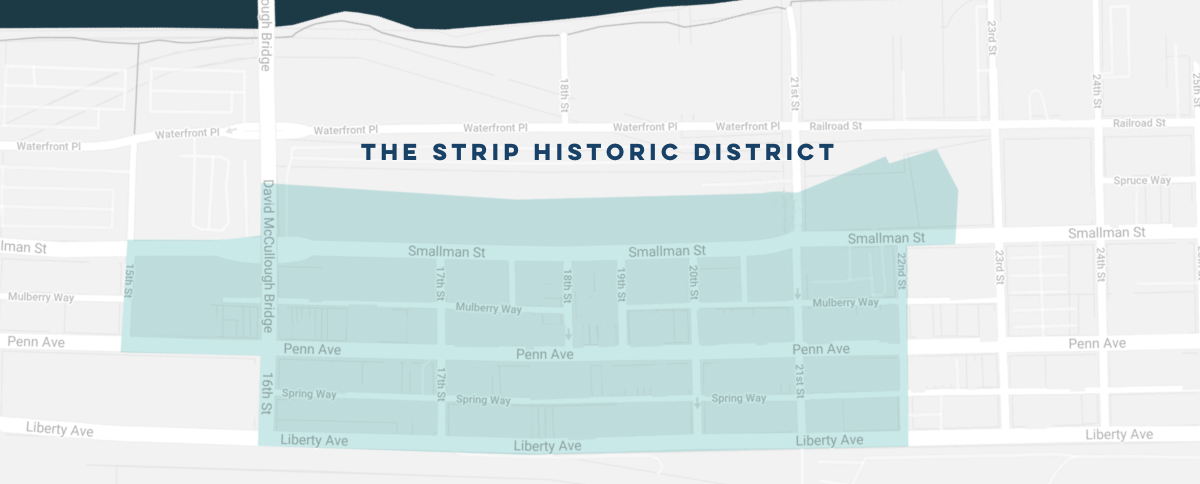
While the Strip Historic District initially developed in the mid-nineteenth century as an industrial center with numerous iron mills, foundries and factories, its street patterns and architecture reflects the neighborhood's history as the epicenter of the regional produce industry and the hub for specialty food products.
The architectural character of the Strip District reflects over 100 years of construction, ranging from one- and two-story brick commercial buildings to ten-story reinforced concrete buildings in various styles, with early twentieth century-style commercial buildings dominating the streetscape. Low-rise buildings tend to be clustered along Penn Avenue with a few multi-story buildings interspersed along the corridor. Larger warehouse and industrial buildings tend to be clustered along Smallman Street near the former Pennsylvania Railroad Fruit Auction & Sales Building. The architectural styles reflected in the district illustrate its 100-year period of vitality with a few examples of early styles such as Greek Revival and Late Victorian, a more prevalent representation of the Commercial Style, Classical Revival, and Late Gothic Revival styles of the late nineteenth and early twentieth centuries, and several examples of the later Art Deco style of the 1920s and 1930s. Surviving mid- to late-nineteenth century buildings are scattered along Penn Avenue, but early twentieth-century commercial buildings dominate the landscape.1
As described in the National Register of Historic Places submission, Pittsburgh's Strip District developed quickly during the early- to mid-nineteenth century. From 1800 to 1860 the area transformed from a "rural retreat" to an area densely populated with homes, shops, schools, and churches.
Pittsburgh's Strip District
The area between 11th and 15th Streets was platted in 1814 and called the Northern Liberties of Pittsburgh. In 1829, the eastern border of the Northern Liberties was expanded to present-day 19th and 20th Streets.
The Northern Liberties was annexed by the City of Pittsburgh as the Fifth Ward in 1837, and the area from 20th to 31st Streets was annexed by Pittsburgh in 1846 as the Ninth Ward. Substantial residential, commercial, and industrial development of the area occurred between 1840 and 1870. By mid-century, in addition to residents beginning to refer to the neighborhood as the "Strip District" based on its geographic qualities, the area was a vital and significant industrial center in Pittsburgh, with 16 iron and steel mills, foundries, and factories. By the 1860s, the population of the Strip District rose to approximately 12,000 residents; many of the residents worked as skilled laborers in the iron mills and glass houses.2
In 1852, the main line of the Pennsylvania Railroad was completed between Philadelphia and Pittsburgh, running through the Strip District on the south side of Liberty Avenue. The Allegheny Valley Railroad was completed to Pittsburgh from Oil City in 1870 on an alignment along the south side of the Allegheny River. A frame freight station was constructed in the 1870s on the north side of Railroad Street between 16th and 17th streets.
Technological advances and the mechanization of iron and steel manufacturing processes brought about the demise of the iron rolling mill and the birth of larger, more fully integrated steel mills. The coke blast furnace, the Bessemer converter, and the open-hearth furnace established the "steel era." Steel mills and associated industries in the Strip contributed to Pittsburgh's national leadership in the production of steel between 1861 and 1905.3
Defining the Area
But with the closing of the Liberty Avenue freight line in downtown Pittsburgh and the establishment of a produce yard in the Strip District, the Allegheny Valley Railroad was leased by the Pennsylvania Railroad in 1900 and was purchased outright in 1910. It was at this time that the Strip District began the transition into a produce distribution center and the overall layout of the area as it exists today started to be defined.
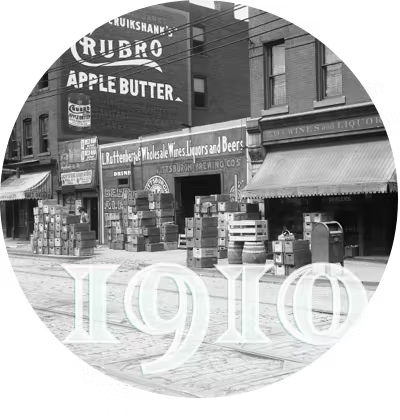
The district's location relative to downtown is critical to the understanding of the area and to its evolution into Pittsburgh's wholesale produce distribution center. Situated just behind the city's central business district and immediately accessible to established major rail lines and early major road networks, this location is precisely why the district developed and prospered for decades.4

Producing History
Wholesale produce merchants first began streaming out of downtown to the neighboring Strip District around 1905. In response, enterprising real estate developer Joseph Watson Craig purchased land along the south side of Smallman Street and constructed a series of three- and four-story warehouses from 18th to 21st Streets. Between 1910 and 1930, the Pennsylvania Railroad expanded its freight yards so that they covered almost the entire area between 11th and 21st streets and Smallman Street and the Allegheny River.6
Homes and small manufacturing buildings were demolished and produce warehouses began to line the south side of Smallman Street. Some small neighborhood shops along Penn Avenue gave way to four-story and five-story buildings for wholesale produce merchants. Produce auction houses and wholesalers located mainly on Smallman Street, and smaller dealers located in shops mainly on Penn Avenue. "There was a strong tendency for dealers to congregate in any given location once a market was established. Sellers wanted to be where the buyers were in the habit of coming. Buyers, for their part, liked to shop and compare prices and quality and would perhaps buy one thing from one dealer and something else from another." 7
"After a boom in production during World War I, the steel industry in the Strip District experienced a steady decline. Modern mills required larger tracts of land than the Strip District had to offer. Firms closed their doors or moved elsewhere. The Depression also took a heavy toll, and several Strip District firms closed during the 1930s. In spite of difficult times, the wholesale produce business continued to grow and became firmly established in the Strip District. 8
Times Are Changing
By the start of the twentieth century, Pittsburgh had grown to become one of the principal auction markets in the United States. In 1906, 48 produce wholesalers supplied 178 fruit retailers in Pittsburgh and Allegheny City, with the majority of wholesalers operating within the Strip Historic District boundaries. By 1929, when the new Pennsylvania Railroad Fruit Auction & Sales Building opened, 80 fruit wholesalers and brokers were supplying 257 fruit retailers.9
By the 1950s, Pittsburgh was the produce distribution center for 31 surrounding counties. There were 141 wholesale produce facilities in the Pittsburgh area, and 71 of those were in the Strip District.10 At this time, Strip District wholesalers were still serviced by rail: Fruits and vegetables arrived at the produce yards and were transferred to the Pennsylvania Railroad Fruit Auction & Sales Building to be sold at its integral auction house, or produce was sold directly from boxcars in the rail yard.
But that was all about to change.
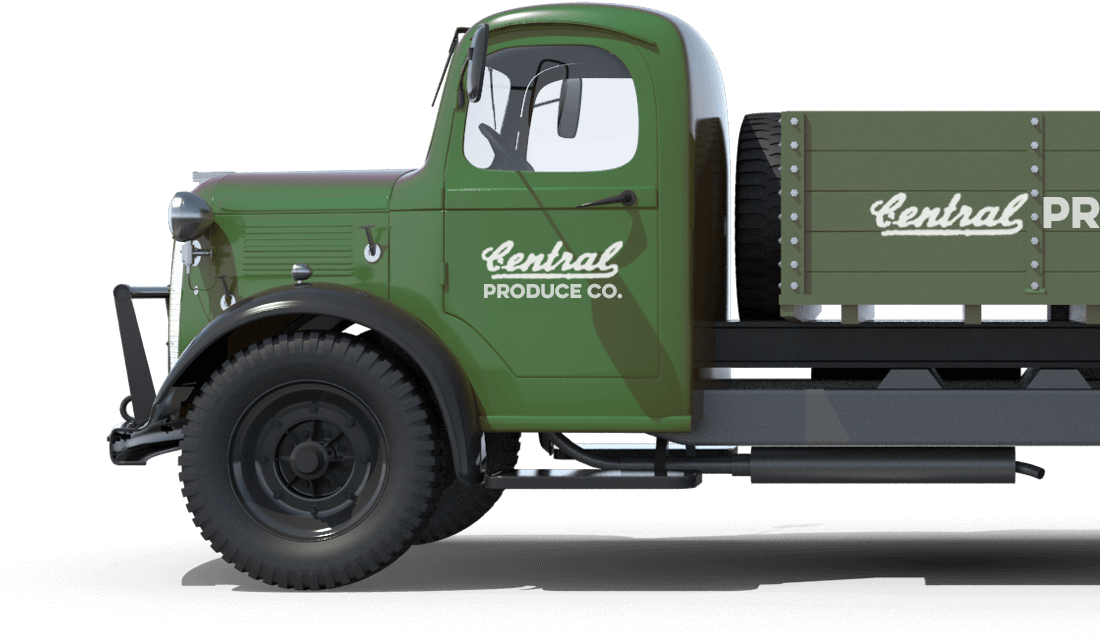
In 1952, Strip District wholesalers received 30 percent of fruits and vegetables by truck. By 1959, 50 percent of produce arrived by truck.
The railroad reacted to this competition by refusing to let trucks park next to the terminal. This forced wholesalers to find other storage space for produce. Express companies responded to the railroads by setting up headquarters on the 2200 block of Smallman Street, a block away from the terminal.11
By the mid-1960s, only 30 to 40 percent of the city's produce was moving through the facilities in the Strip Historic District.12 Additionally, the original generation of produce workers were nearing retirement and the Produce Terminal was showing its age. After declaring bankruptcy in 1970, much of the Penn Central Transportation Company's land holdings in the western part of the Strip District was sold to developers.13
Though the produce industry changed drastically in the second half of the twentieth century, some wholesale firms stayed in the Strip and continued to operate out of the Terminal building. By the mid-1970s, only about 24 wholesalers were operating out of the Pennsylvania Railroad Fruit Auction & Sales Building under a lease from Conrail. Some of the remaining produce firms expanded to retail and began to open direct-to-consumer food shops on Penn Avenue. 14
In 1981, the Urban Redevelopment Authority (URA) used $1.1 million of City of Pittsburgh/1-IUD Community Development Block Grant funds to purchase the Pennsylvania Railroad Fruit Auction & Sales Building in order to preserve it for use as a produce distribution center and to prevent alternate-use development.
In 1983, the URA renovated the building to convert the former auction wing into modern office space, added the sawtooth loading docks on the building's north side, and removed a bay on the west end to accommodate trucks.
In 1986, the updated building continued to serve as a viable produce distribution center and also became home to The Society for Contemporary Craft, a mixed-media art gallery and interactive space for the community.
But by the mid-1990s, about a dozen produce wholesalers were operating in the Strip District. By 2010, only eight produce distributors operated from the building.15
Retail replaced wholesale and came to dominate the Penn Avenue corridor of the Strip District. Even today, patrons still come to the Strip to purchase produce, but now they stay to indulge in specialty and ethnic food items, to shop for hip clothes and home goods, and to dine at restaurants and bars. But the Strip District still is one of the most distinctive, recognizable and authentic neighborhoods in the City of Pittsburgh. Despite various urban renewal efforts in the 1970s to the 1990s, the dynamic district has maintained its character and continues to operate, in some ways, as it did 100 years ago.
The Strip District Terminal opened in 1929 as the Pennsylvania Railroad Fruit Auction & Sales Building to serve the tri-state area as a produce distribution hub. Iconic in length and design, the terminal functioned as the economic heart of the Strip District for more than 40 years.
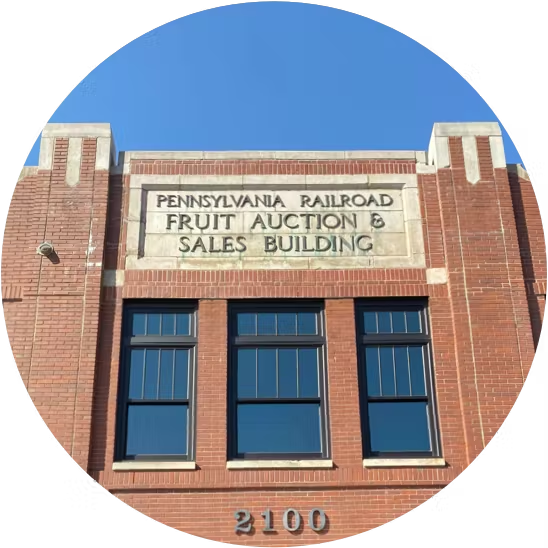
Produce Distribution Hub
The Produce Terminal building was designed for transferring goods from one carrier to another with minimal provision for short-term storage. Perishable produce arrived, was inspected by potential buyers, and then was auctioned at the two-story east end of the building, after which it was transferred to the buyer for transport.
The one-story length of the inspection shed was designed for loading and unloading boxcars from either side, with identical doors with box car spacing along each elevation. The red brick construction, Art Deco-influenced detailing of the brick and limestone parapet walls, and the original steel sash clerestory and monitor windows of the inspection shed continue to be character-defining features, even today. The most notable features are the paneled wood, center-hinged fold-up cargo doors on the inspection shed. While the loading docks at the real elevation were reconstructed in 1995, the original copper canopy remains. At the Smallman Street elevation, although slightly modified with the installation of stairs and railings, the original concrete loading dock and cantilevered steel frame canopies also remain.
The low-rise, 1920s-era building extended five blocks along the northwest side of Smallman Street, while a mix of late- nineteenth and early-twentieth-century low-rise and multi-story warehouse and industrial buildings lined the street's southeast side. The pronounced setback of the Produce Terminal building widened the portion of Smallman Street from 16th Street to 21st Street to allow for the loading of vehicles from its elevated platforms. This dramatic five-block-long expanse is bordered lengthwise on the northwest by the terminal building and on the southeast by large multi-story former produce warehouses and industrial buildings, terminating with the façade of St. Stanislaus Kostka Roman Catholic Church centered along its northeast side. The visual result is that of an open market plaza, which is a character-defining feature of the Strip Historic District that very much contributes to the feeling of a produce distribution center and marketplace.
The pivotal building takes up the majority of the northwest boundary of the district, influencing other prevalent design aspects of the district, including the plaza area of Smallman Street between 16th and 21st streets and the location of several large produce businesses along the southeast curb line of Smallman Street. Its influence is also prevalent in the rhythm of the surrounding buildings including those facing Smallman Street – some of the largest in the district – the one- and two-story buildings flanking Penn Avenue, and in the more modern, low-rise buildings which face Liberty Avenue.16
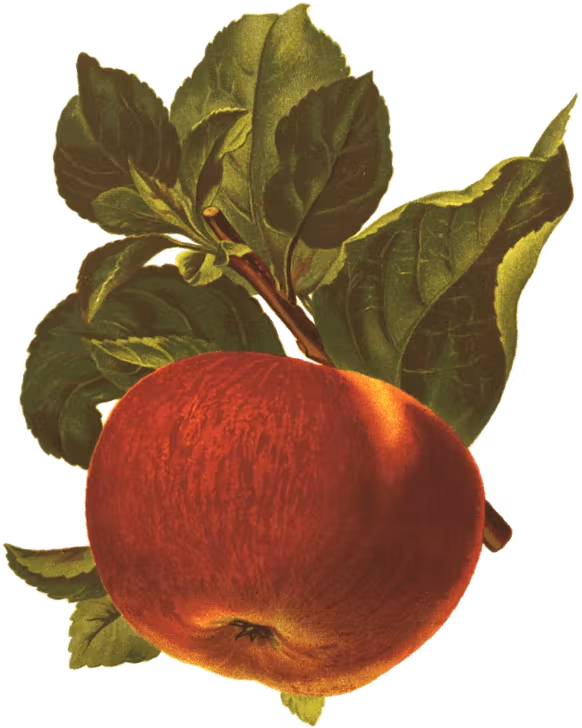
Looking to the Future
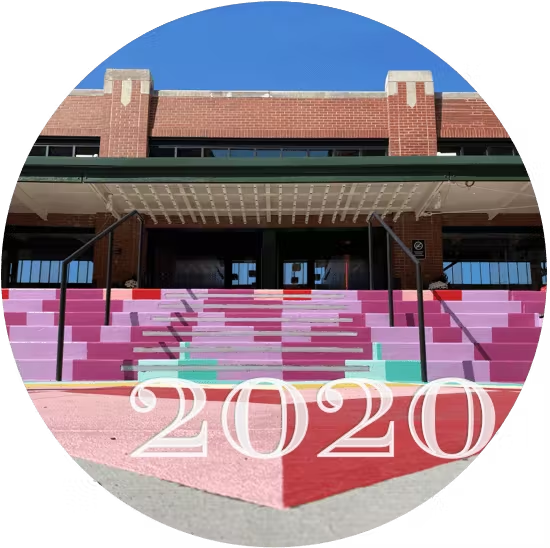
A Mixed-Use Vision
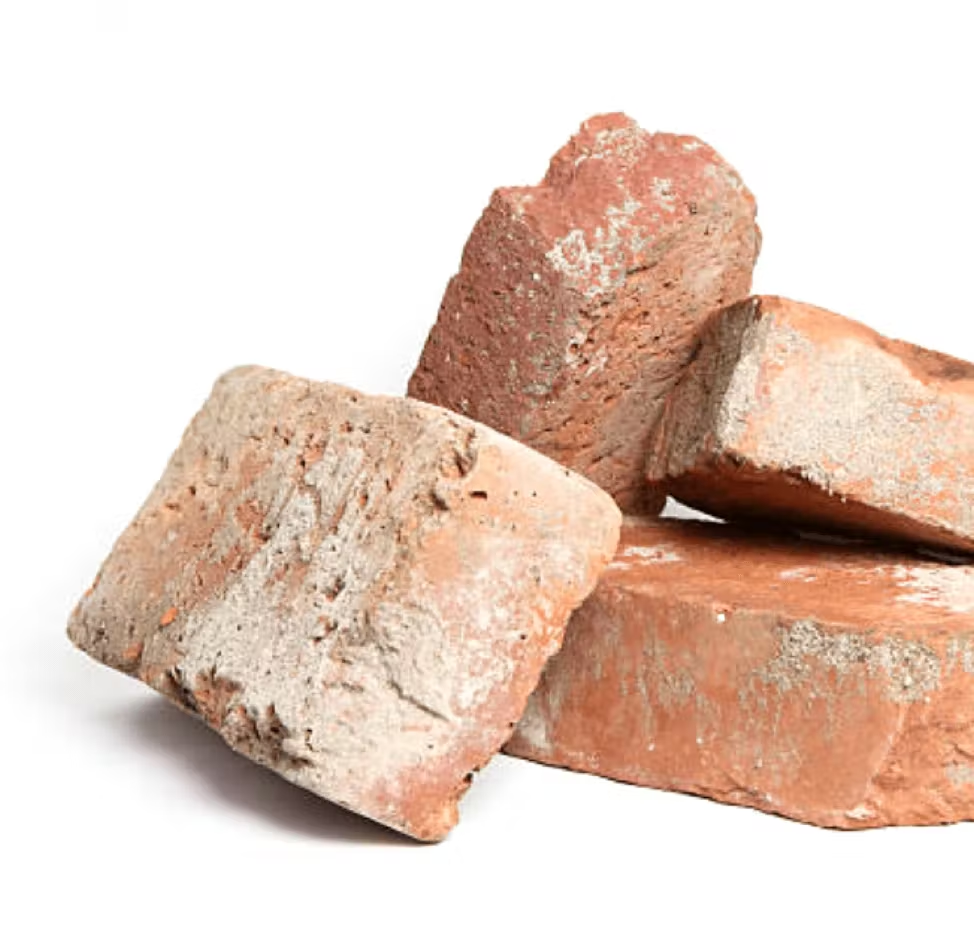
Breaking Ground
In 2019, the URA granted McCaffery a 99-year ground lease of the Produce Terminal. Later that year, ground was broken, and the new Strip District Terminal was launched. In collaboration with the City of Pittsburgh, its design partners and the Pittsburgh Water and Sewer Authority, Smallman Street infrastructure is being updated in conjunction with building construction to serve as a new transit corridor, complement the Penn Avenue retail and dining, and create a whole new destination in the Strip.See Our Vision
- National Register of Historic Places, Strip Historic District, Pittsburgh, Allegheny County, Pennsylvania, National Register #14000194, section 7, page 5.
- Uhl, Lauren and Tracy Walther, "Historic and Architectural Survey of the Strip District," 1994:E5-6 , as cited in National Register of Historic Places Nomination Form Strip Historic District, Pittsburgh, Allegheny County, Pennsylvania, National Register #14000194, section 8, page 18.
- Uhl, Lauren and Tracy Walther, "Historic and Architectural Survey of the Strip District," 1994:E16 , as cited in National Register of Historic Places Nomination Form Strip Historic District, Pittsburgh, Allegheny County, Pennsylvania, National Register #14000194, section 8, page 19.
- National Register of Historic Places, Strip Historic District, Pittsburgh, Allegheny County, Pennsylvania, National Register #14000194, section 7, page 13.
- National Register of Historic Places, Strip Historic District, Pittsburgh, Allegheny County, Pennsylvania, National Register #14000194, section 7, page 13.
- Uhl, Lauren and Tracy Walther, "Historic and Architectural Survey of the Strip District," 1994:E17 , as cited in National Register of Historic Places Nomination Form Strip Historic District, Pittsburgh, Allegheny County, Pennsylvania, National Register #14000194, section 8, page 21.
- Erdman, Henry E., "American Produce Markets," D.C. Health and Company, Boston, 1928, as cited in National Register of Historic Places Nomination Form Strip Historic District, Pittsburgh, Allegheny County, Pennsylvania, National Register #14000194, section 8, page 27.
- Uhl, Lauren and Tracy Walther, "Historic and Architectural Survey of the Strip District," 1994:E38 , as cited in National Register of Historic Places Nomination Form Strip Historic District, Pittsburgh, Allegheny County, Pennsylvania, National Register #14000194, section 8, page 21.
- National Register of Historic Places, Strip Historic District, Pittsburgh, Allegheny County, Pennsylvania, National Register #14000194, section 8, page 29.
- U.S. Food and Drug Administration, 1964, as cited in National Register of Historic Places Nomination Form Strip Historic District, Pittsburgh, Allegheny County, Pennsylvania, National Register #14000194, section continuation 1, page 1.
- Uhl, Lauren and Tracy Walther, "Historic and Architectural Survey of the Strip District," 1994:E46 , as cited in National Register of Historic Places Nomination Form Strip Historic District, Pittsburgh, Allegheny County, Pennsylvania, National Register #14000194, section continuation 1, page 5.
- Smith, Eliza, "Historic Sites Survey of Allegheny County: Strip District," 1979, as cited in National Register of Historic Places Nomination Form Strip Historic District, Pittsburgh, Allegheny County, Pennsylvania, National Register #14000194, section 8 page 24.
- Uhl, Lauren and Tracy Walther, "Historic and Architectural Survey of the Strip District," 1994:E47 , as cited in National Register of Historic Places Nomination Form Strip Historic District, Pittsburgh, Allegheny County, Pennsylvania, National Register #14000194, section 8, page 24.
- National Register of Historic Places, Strip Historic District, Pittsburgh, Allegheny County, Pennsylvania, National Register #14000194, section 8, page 24.
- Ibid, section 8, page 25.
- Ibid, section 7, page 13.
Strip District Terminal, subscribe for email updates.



